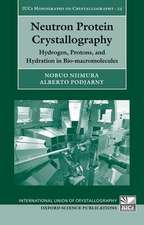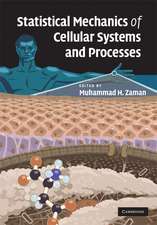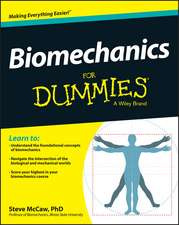Cell Membranes: Methods and Reviews Volume 3
Editat de E. Elson, W. Frazier, L. Glaseren Limba Engleză Paperback – noi 2011
Preț: 394.87 lei
Nou
Puncte Express: 592
Preț estimativ în valută:
75.56€ • 79.05$ • 62.77£
75.56€ • 79.05$ • 62.77£
Carte tipărită la comandă
Livrare economică 02-16 aprilie
Preluare comenzi: 021 569.72.76
Specificații
ISBN-13: 9781461290650
ISBN-10: 1461290651
Pagini: 432
Ilustrații: 432 p.
Dimensiuni: 152 x 229 x 23 mm
Greutate: 0.58 kg
Ediția:Softcover reprint of the original 1st ed. 1987
Editura: Springer Us
Colecția Springer
Locul publicării:New York, NY, United States
ISBN-10: 1461290651
Pagini: 432
Ilustrații: 432 p.
Dimensiuni: 152 x 229 x 23 mm
Greutate: 0.58 kg
Ediția:Softcover reprint of the original 1st ed. 1987
Editura: Springer Us
Colecția Springer
Locul publicării:New York, NY, United States
Public țintă
ResearchCuprins
1 Regulation of Development by the Extracellular Matrix.- 1. Introduction.- 2. Molecular Analysis, Localization, and Functions of Cell-to-SubstrateAdhesion Molecules.- 3. Involvement of Cell—Substratum Adhesion Molecules in EmbryonicCell Migration.- 4. Involvement of Cell—Substratum Adhesion Molecules in Tissue Remodeling.- 5. Concluding Remarks.- References.- 2 Thrombospondin: A Multifunctional Platelet and Extracellular Matrix Glycoprotein.- 1. Introduction.- 2. Structure and Molecular Interactions of Thrombospondin.- 3. Roles for Thrombospondin in Platelet Function.- 4. Presence of Thrombospondin in Extracellular Matrices.- 5. Possible Functional Roles for Thrombospondin in the ExtracellularMatrix.- 6. Synopsis.- References.- 3 Neuronal Antigens Involved in Cell Adhesion and Cell Recognition.- 1. Introduction.- 2. Identification of Neural Antigens Using Immunological Approaches.- 3. Role of Identified Antigens in Neuronal Cell Recognition.- 4. Neuronal Cell-Adhesion Molecules.- 5. N-CAM.- 6. Relationship of N-CAM to Other Neuronal Cell-Adhesion Molecules.- 7. Conclusions.- References.- 4 Mechanisms of ?1-Adrenergic and Related Responses: Roles ofCalcium, Phospoinositides, Guanine Nucleotides, Diacylglycerol,Calmodulin, and Changes in Protein Phosphorylation.- 1. Introduction.- 2. The ?1Adrenergic Receptor.- 3. Changes in Cell Ca2+ Induced by ?1Adrenergic Agonists.- 4. Role of Phosphoinositide Changes.- 5. Role of Guanine Nucleotide—Binding Regulatory Protein.- 6. Role of Myoinositol Trisphosphate and Ca2+ Release.- 7. Role of Diacylglycerol and Protein Kinase C.- 8. Role of Ca2+ -Calmodulin-Regulated Enzymes and Other Proteins.- 9. Summary.- References.- 5 Regulation of Protein Kinase C by Lipid Cofactors.- 1. Introduction.- 2. Activation of Protein Kinase Cin Vivo by Diacylglycerols.- 3. Activation of Protein Kinase C in Vitro.- 4. Conclusions.- References.- 6 Protein Kinase C and Its Role in Cell Growth.- 1. Introduction.- 2. Protein Kinase C.- 3. Identification of Substrates for Protein Kinase C.- 4. Cellular Effects of Tumor Promoters.- 5. Interaction of Protein Kinase C with Other SignalingSystems.- 6. Conclusions and Perspectives.- References.- 7 Modulation of the Extracellular Matrix by Tumor Cell—FibroblastInteractions.- 1. Introduction.- 2. Effect of Tumor Cell—Fibroblast Interactions on Production of Matrix-Degrading Enzymes.- 3. Effect of Tumor Cell—Fibroblast Interactions on Production ofExtracellular Macromolecules.- 4. Cell—Cell Interactions and Extracellular Matrix Modulation inEmbryonic Development, Tissue Regeneration, and Tumor Invasion.- References.- 8 Early Cytoplasmic Signals and Cytoskeletal Responses Initiated byGrowth Factors in Cultured Cells.- 1. Introduction.- 2. Ions as Signals.- 3. Inositol Lipid Metabolites as Signals.- 4. cAMP as a Signal.- 5. Protein Phosphorylation as a Signal.- 6. Mechanisms of Desensitization to Growth Factor Stimulation.- 7. Cell Shape and Motility.- 8. Cytoskeleton.- 9. Phorbol Esters and the Cytoskeleton.- 10. Cytoplasmic pH and the Cytoskeleton.- 11. Model of the Role of the Ca2+ Signaling Pathway in Regulating theActin-Based Cytoskeleton.- 12. Prospectus.- References.












